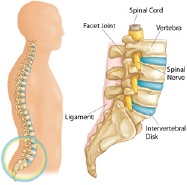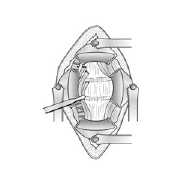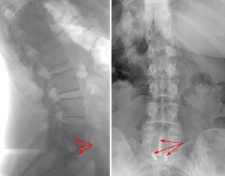Anterior Lumbar Interbody Fusion
Spinal fusion is a surgical procedure used to correct problems with the small bones in the spine (vertebrae). It is essentially a "welding" process. The basic idea is to fuse together the painful vertebrae so that they heal into a single, solid bone. Spinal fusion is a treatment option when motion is the source of pain — the theory being that if the painful vertebrae do not move, they should not hurt.
An interbody fusion is a type of spinal fusion that involves removing the intervertebral disk. This type of fusion can be performed using different approaches. For example, the surgeon can access the spine through incisions in the lower back or through incisions in the side. In an anterior lumbar interbody fusion (ALIF), the surgeon approaches the lower back from the front through an incision in the abdomen.
This article focuses on anterior lumbar interbody fusion and discusses only the surgical component of the procedure. For a complete overview of spinal fusion, including approaches, bone grafting, complications, and rehabilitation, please go to Spinal Fusion.

In an anterior lumbar interbody fusion, the intervertebral disk is removed.
Surgical Procedure
Approach
Although most spinal surgeries are performed using a posterior (back) approach, your surgeon may choose an anterior approach for several reasons, including:
- To avoid multiple surgeries in one area if you have already had previous spinal surgeries using a
- posterior (back) approach.
- To allow more direct access to the intervertebral disk.
- To have the ability to add more lordosis (swayback) to your spine.
- Your recovery may be quicker.
In contrast to a posterior approach to low back surgery, when your surgeon uses an anterior approach he or she can access your spine without moving the nerves. Organs and blood vessels must be moved to the side with an anterior approach, however. In most cases, a vascular surgeon assists the orthopaedic surgeon with opening and exposing the disk space.

In an anterior approach, organs and blood vessels are moved to the side to expose the disk space. Reproduced from Flatow E, Colvin AC (eds.): Atlas of Essential Orthopaedic Procedures. Rosemont, IL, Academy of Orthopaedic Surgeons, 2013, p. 561.
Surgical Technique
Most interbody fusions take from 2 to 3 hours.
In the first part of the procedure, your surgeon will remove the intervertebral disk from the disk space. When the disk space has been cleared out, he or she will implant a metal, plastic, or bone spacer between the two adjoining vertebrae. This spacer, or "cage," usually contains bone graft material. This promotes bone healing and facilitates the fusion.

(Left) This X-ray of the lumbar spine shows decreased disk space between the vertebrae. (Right) An interbody cage has been inserted with an ALIF procedure. The bone graft is contained within the metallic cage and cannot be seen.
After the cage is placed in the disk space, your surgeon may add stability to your spine by using a plate or screws to hold the cage in place. In some cases, this may be done through the same incision. In other cases, however, your surgeon may need to place additional screws to the back of your spine through a separate incision. Before your procedure, your surgeon will talk with you about what which option will work best in your case.

In these x-rays, taken from the side (left) and front (right), screws have been added to hold an interbody cage in place and add stability to the spine.
Recovery
In most cases, you will stay in the hospital from 1 to 3 days following ALIF. The length of your stay will depend upon how well-controlled your pain is and your ability to stand and move around.
Most patients are encouraged to stand and walk by the first day after surgery. Your surgeon may provide you with a back brace to help make you more comfortable and to protect the surgical fusion.
You will perform basic exercises, including routine walking, during the first several weeks after surgery. During this time, it is important to avoid bending with your back, twisting, or lifting anything heavy.
Most patients who undergo ALIF can expect improvement of lower back pain and disability in weeks to months following surgery.













